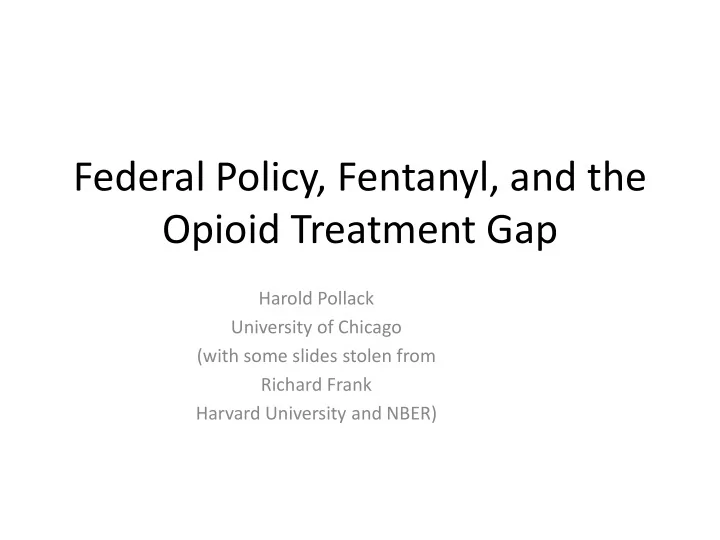

Federal Policy, Fentanyl, and the Opioid Treatment Gap Harold Pollack University of Chicago (with some slides stolen from Richard Frank Harvard University and NBER)
Fentanyl as key public health threat • Fentanyl, a powerful synthetic opioid, poses an increasing public health threat. • Fentanyl plays a major role in rising mortality due to heroin or opioid overdose. • Overdose itself is not a new problem. – Street cohort studies of PWID always found high OD fatalities, typically 1-2% /yr. – Ten years ago, more Chicagoans were dying from OD than car accidents — often with fentanyl involvement--though the policy community didn’t particularly believe it. • But problem is getting worse quickly, and affecting non- Hispanic whites in particularly high numbers — a fact addiction policymakers in both parties freely note.
Fentanyl as key public health threat • Low production costs encourage suppliers to “cut” heroin with the drug, particularly white powder heroin sold in eastern states. – Even with declining prices, heroin costs about $65,000 per kilogram wholesale, whereas illicit fentanyl is available at roughly $3,500/kg. – A prevalent active ingredient in counterfeit OxyContin (oxycodone) tablets. • Poses particularly serious overdose risk because it can rapidly suppress respiration and thus cause death more quickly.
Some selection bias operating here, but large increase in detected presence of fentanyl
Fentanyl, heroin, and rising mortality Figure from Frank and Pollack (2017)
Even more scary graph from the New York Times
Powder vs. Black Tar in OD deaths (Philadelphia vs. San Francisco)
Break from depressing topics
Menu of choices to address the problem • Expanded treatment access – including through Medicaid expansion – Complementary measures such as CURES Act funds. • Improved prescribing practices (important, though beyond my scope). • Harm reduction public health measures • Harm reduction policing
Prevalence of Opioid Use Disorder (OUD) and Substance Use Disorder (SUD) United States, 2015 OUD prevalence (per 1,000) SUD prevalence (per 1,000) Total Income 0 – 100% FPL 16.8 47.1 101 – 200% FPL 15.0 36.8 >200% FPL 11.4 28.4 Age 18-25 14.7 52.8 26-34 17.0 34.0 35-49 10.9 19.7 50-64 7.2 12.4 Gender Male 16.5 43.3 Female 10.4 26.3 Race Non-Hispanic White 15.2 35.8 Non-Hispanic Black 8.1 32.6 26% Hispanic 10.7 28.5 In Treatment 3.4 4.8 Overall Prevalence 13.3 34.2 Richard Frank Tabulation of NHSDUH, 2015
Some of the treatment gap is addressable through basic access • Reason for not getting treatment – Cost/Affordability (36%) – Availability (16%) – Stigma (22%) – Not a problem/Not ready to stop (29+%) • Addressable gap: what is amenable to policy – Maybe 50% to 60% – More attractive treatment integrated with primary care hoped to reduce stigma and related barriers.
Federal Tools • Changing the Covered Population – Medicaid Expansion – Subsidized Private Coverage • In NDATSS qualitative surveys of policymakers and addiction providers in eight states, opioid epidemic played surprisingly large political role in enacting/maintaining health coverage. • Changing Extent of Coverage – Essential Health Benefits – Parity • Targeted Grants – Ad hoc grants (e.g. $100 million FY16 grants to FQHCs) – 21 st Century Cures (formula grants based on need and resources)
Some early lessons • Specialty treatment far more likely to join medical care homes in expansion states ( D’Aunno , Pollack, et al. 2016). • New private equity M/SUD capacity investments in response to coverage expansions. • In expansion states, the number of patients who used Medicaid to pay for specialty addiction treatment increased by 57 percent — with largely but not automatically beneficial systemic effects (Maclean & Saloner 2017).
Some early lessons • Specialty treatment admission did not expand much in response to Medicaid expansion (Maclean & Saloner 2017 — see below) • MAT, especially Buprenorphine, increased 33% faster in expansion relative to non-expansion states (Maclean and Saloner 2017 — see below) • No evidence that expanding Medicaid led to more overdoses or alcohol poisonings
Medicaid expansion is the central tool to expand treatment access • Example: Kentucky – Kentucky received a $10.5 million grant under 21 st Century Cures – At $5,500 per person per year for MAT, that buys 1,900 person years of treatment – Kentucky Medicaid purchased an estimated 4,180 person years of Buprenorphine in 2016 (73% from expansion) • Correctional populations and other severely vulnerable groups engaged by Medicaid expansion. • If Medicaid expansion were repealed, the offsetting overall loss of care access to individuals with addiction disorders would require on the order of $183 billion over next ten years.
Menu of choices to address the problem • Expanded treatment access • Harm reduction public health measures – Syringe exchange to engage users where they are – Supervised injection sites have potential in international work, though significant challenges. – User/first-responder Naloxone, which may require some dosing adjustments to be maximally effective. – Testing equipment for buyers and sellers, which require careful evaluation to understand effective, nature of use. • Harm reduction policing using carrots and sticks – Seeking to deter introduction of fentanyl and related products — particularly to unknowing users. – Drug-selling organizations are low-cost avoiders for introduction of fentanyl into illicit drugs.
Observations • Coverage Expansion playing a critical role. • Illicit drug markets are fundamentally changing and perhaps becoming more lethal in unexpected ways. • Engagement: Meeting people where they are – Naloxone – Needle exchanges – Supervised injection sites – First responder linkages • The necessity and the difficulty of harm reduction for PWID. – Engaging law enforcement systematically – Rigorous evaluation using the full tools of comparative effectiveness research.
Thank you
Recommend
More recommend